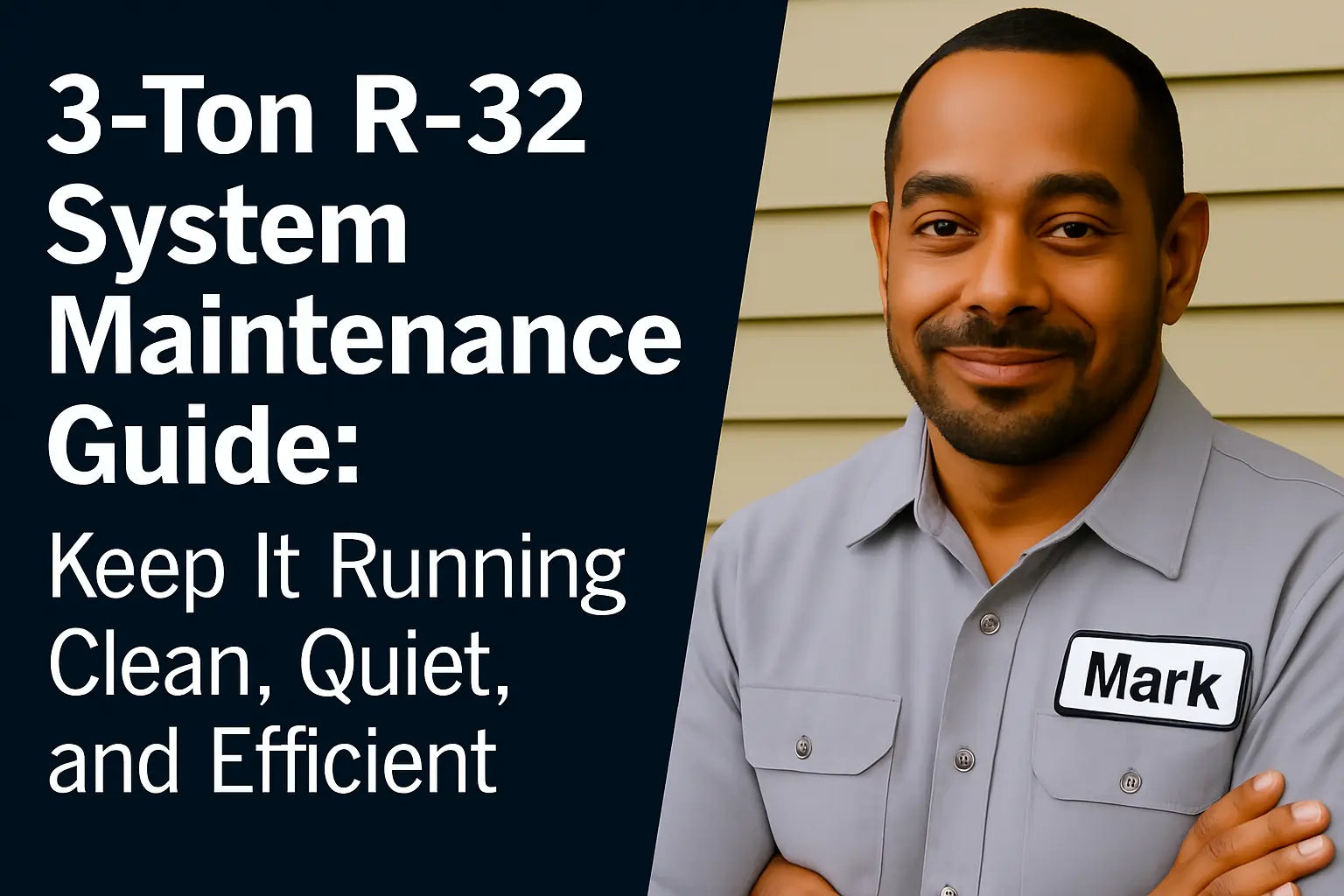🛠️Mark’s Straight Talk on Why Maintenance Matters
If you want your 3-ton R‑32 AC system to perform like a champ for years, maintenance isn’t optional — it’s mission-critical. I’m Mark, and over the years, I’ve seen perfectly good HVAC systems turned into costly nightmares just because someone skipped a filter change or ignored a minor leak.
R‑32 systems are modern and efficient, but they still have parts that wear out, get dirty, or need tuning. Unlike some throwaway tech, these units can last 15 years or more with the right care.
In this guide, I’ll walk you through exactly what maintenance steps you need to do, when to call a pro, and how to avoid common pitfalls. Whether you’re a hands-on homeowner or just like knowing what’s going on under the hood, this is your go-to for clean, quiet, and efficient cooling.
Ready? Let’s get into it. 🧰❄️
🔍 Inspect and Replace Air Filters Regularly
Air filters are your system’s first line of defense against dust, dirt, and allergens. A clogged filter reduces airflow, making your compressor work overtime, which drives up energy bills and shortens equipment life.
Check your filter at least every 1 to 3 months during the cooling season. Disposable fiberglass filters should be replaced monthly. Higher quality pleated filters can last up to 3 months but still need regular checks.
Skipping this simple step invites dust buildup on the evaporator coil, reducing heat exchange efficiency. It can also cause freeze-ups or cause the system to cycle excessively.
For more on filter types and maintenance schedules, check out the EPA’s Air Filter Basics.
🧹 Clean the Condenser Coils Annually
The outdoor condenser coils are exposed to dirt, pollen, leaves, and pollution. When these coils get dirty, they can’t dissipate heat effectively. Your system works harder, uses more electricity, and risks overheating.
Plan to clean the condenser coils at least once a year—usually in spring before the hot months. You can gently hose them down, but avoid using a pressure washer as it can bend fins.
For stubborn grime, a coil cleaner formulated for AC units can help. Just be sure to follow safety instructions, especially since R‑32 systems require care due to their A2L refrigerant classification.
Learn proper cleaning techniques in this ASHRAE Maintenance Guide.
🔧 Check Refrigerant Levels and Look for Leaks
R‑32 systems are charged precisely by weight, and leaks can drastically affect performance. Low refrigerant causes the system to freeze up or fail to cool properly.
Watch for signs like ice buildup on the coil, hissing noises, or noticeable performance drops. If you suspect a leak, call a licensed technician who is certified to handle A2L refrigerants like R‑32.
The EPA’s Refrigerant Management Guide has detailed rules on leak detection, repair timelines, and proper refrigerant handling.
🛡️ Inspect Electrical Components and Connections
Loose or corroded electrical connections cause frequent breaker trips and can damage your compressor or fan motors. At least once a year, a pro should inspect electrical contacts, capacitors, and wiring.
If you hear buzzing noises or notice the unit randomly shutting off, that’s a red flag. Tightening and replacing worn parts early avoids expensive failures down the road.
💨 Maintain Proper Airflow and Ventilation
Blocked or leaky ductwork reduces system efficiency and indoor air quality. Check your ducts for leaks, damage, or disconnections. Make sure supply and return vents are open and unblocked by furniture or curtains.
Poor ventilation means your AC system works overtime just to keep your home comfortable. A professional duct test and sealing can improve efficiency by 15% or more, according to the Building Performance Institute.
🎚️ Calibrate Thermostat and Controls
An improperly calibrated thermostat causes the system to short cycle or run endlessly. Check that your thermostat is level, away from heat sources, and set to the correct mode.
Upgrading to a smart thermostat not only improves comfort but can save energy by learning your habits. Check out ENERGY STAR’s guide on smart thermostats.
🔄 Schedule Annual Professional Tune-Ups
Even if you keep up with basic tasks, an annual professional tune-up is worth the investment. A trained technician will:
-
Measure system pressures and temperatures
-
Verify refrigerant charge
-
Clean internal components
-
Test safety controls
-
Lubricate moving parts
This comprehensive check keeps small issues from snowballing into costly repairs. Many manufacturers require annual maintenance to keep warranties valid.
🧹 Keep the Area Around Your Outdoor Unit Clear
Leaves, grass, and debris blocking your outdoor unit reduce airflow and increase energy use. Keep at least 2 feet of clearance around your condenser. Trim plants regularly, and avoid spraying water or chemicals directly on the unit.
🛎️ When to Call a Pro ASAP
While many maintenance steps can be DIY, call a licensed HVAC tech if you notice:
-
Refrigerant leaks or low pressure
-
Electrical issues or breaker trips
-
Strange odors or smoke
-
Loud or unusual noises
-
Poor cooling despite clean filters and proper settings
🔚 Mark’s Final Word: Keep It Simple, Keep It Smart
Maintenance is the difference between a system that lasts 15 years and one that burns out in 7. R‑32 AC systems are efficient and environmentally friendly, but they need respect and regular care.
Stick to a schedule of filter changes, coil cleanings, and annual tune-ups. Don’t ignore warning signs. Keep your system clean, your airflow clear, and your controls accurate.
And if you’re looking for a reliable new 3-ton R‑32 system or replacement parts, check out The Furnace Outlet’s R‑32 Residential AC Collection. These units are built with safety and efficiency front of mind.
Need more troubleshooting and installation tips for this system? Visit my awesome guide right here!
Stay ahead of problems, save on energy bills, and keep your cool all year long. That’s how you win the HVAC game.
— Mark 😎🧰







